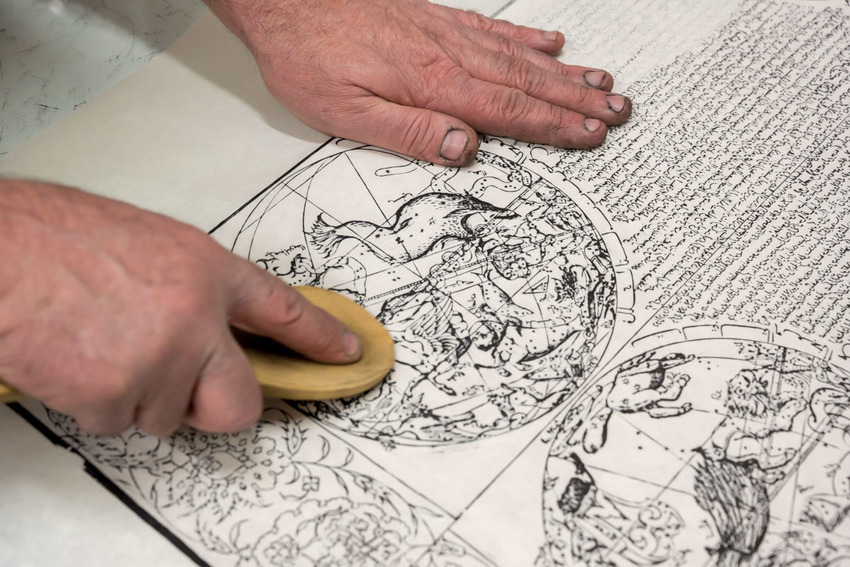
The woodblocks of the Heart-shaped map of Hajji Ahmed © Factum Foundation
The six engraved woodblocks within the Biblioteca Marciana measure 106 x 110 cm. The map is a cordiform projection, a common configuration at the time, with place names written in Arabic letters and a 292-line text in Ottoman Turkish to the left and right. The text is divided into five sections: prologue, introduction, description of the continents, descriptions of the twelve main provinces of the world and of the seven great lords, and epilogue.
In the lower part of the map are an armillary sphere and two celestial spheres. During his evaluation of the text on the woodblocks in 1795, Abbott Simone Assemani, professor of Oriental Languages at the University of Padova, remarked on these two features as “distinctively European” and noticed them appearing in the work of Albrecht Dürer and others during the same period. The map, text, and spheres are framed by a string of floral motifs, broken only at the top by the title, ‘Kemâlîyle naqš olunmıš jümle jihân nümûnesi’, which translates as ‘Perfect and complete engraving and description of the whole world’.

© Factum Foundation
Recording an Ottoman-Venetian world map
In 2019, the Biblioteca Marciana started a project concerning a new philological edition of the Heart-shaped map of Hajji Ahmed, involving a memorandum of understanding between the Venetian institutes of IUAV University Venice (Istituto Universitario di Architettura di Venezia) and the Academy of Fine Arts. In February 2019, Factum Foundation/ARCHiVe collaborated with the IUAV CIRCE Photogrammetry Lab to record the original cherry-wood printing blocks in high resolution. This initiative, led by ARCHiVe, sought to compare and assess the respective merits of the three recording techniques:
- photogrammetry, using a Nikon D800 reflex with a 50mm lens, with the data processing employing the Agisoft Metashape Pro Software;
- laser scanning, using a Range 7 triangulation laser scanner employing both a telephoto lens and a wide-angle lens (precision ± 40 microns), supported by the Geomagic Studio software in the alignment phase;
- the Lucida 3D Scanner, designed by Factum Arte for the acquisition of 3D information from objects with an almost flat surface, such as paintings or bas-reliefs.

A sample of the 3D data captured by the Lucida. © Factum Foundation
The scanned data was CNC-milled and new printing blocks have been produced, from which one printed copy of the map has been made. The milled panels and the new print were shown together in the exhibition ‘The Materiality of the Aura’ in Bologna (May 2020 – February 2021).

The recreation of the woodblocks of the Mappa Turchesca and the print made from the blocks (left) alongside two enlarged pages from the Martirologio di Ferrara (right), made for the exhibition ‘Mindful Hands’ at the Fondazione Giorgio Cini. In the glass case at the centre of the room there are facsimiles of two Canova sketchbooks and the miniature Offiziolo di Carlo VII © Paolo Righi for Genus Bononiae
In November 2020, a team from ARCHiVe completed the recording of the original woodblocks by 3D scanning the back of the panels with the Lucida 3D Scanner. This information has been compiled with the data from the front, to generate a full record of the condition of the woodblocks. The front of the woodblocks have also been recorded with high-resolution panoramic composite photography, which can be registered alongside the 3D data obtained by the Lucida.

Guendalina Damone recording the back of the map of Hajji-Ahmed using the Lucida 3D Scanner © Oscar Parasiego for Factum Foundation
Digital restoration
In the most recent phase of this project, Factum Foundation’s Teresa Casado completed a ‘digital repair’ of the surface of the woodblocks. Using the greyscale depth-map information gathered by the Lucida, cracks and lacunae on the surface of the woodblocks were virtually restored, enabling a new version of the map corresponding to the 1795 prints to be created. The copy of one of these prints at the Biblioteca Marciana has been used as the reference.
Different tests made with both CNC-milling and Canon CPP’s Elevated Printing have been done in collaboration with Biblioteca Marciana to check the restored version of the surface. Further tests will be completed to determine the best prototyping method, before re-materialising the complete set of panels as prints.

Original scanned data © Factum Foundation
The digital restoration process is being done by Factum Foundation’s Teresa Casado working on the greyscale depth-map information from the Lucida using Photoshop.

Detail of the digital restoration of the holes left by woodworms © Factum Foundation

Detail of the digital restoration of the holes left by woodworms (after) © Factum Foundation
One copy of the map was made at the end of 2019 using CNC-milled printing blocks, and different tests have been carried out since to check the restored version of the surface. Canon Production Printing’s elevated printing technology, which was enhanced and applied to cultural heritage projects through Factum’s collaboration and is now in-house in Madrid, is currently showing the best results in terms of accuracy for prototyping a new set of panels.

The recreated woodblocks during printing tests, in Factum Foundation’s printing department © Oak Taylor Smith for Factum Foundation

Detail of the printed edition © Oak Taylor Smith for Factum Foundation

The copy of the Mappa Turchesca printed from the recreated woodblocks © Oak Taylor Smith for Factum Foundation

Small sections of one of the printing blocks, re-materialised with CNC-milling (top) and with CPP’s Elevated Printing (bottom left). Initial printing tests have been made out of the CPP surface (bottom right) © Factum Foundation















